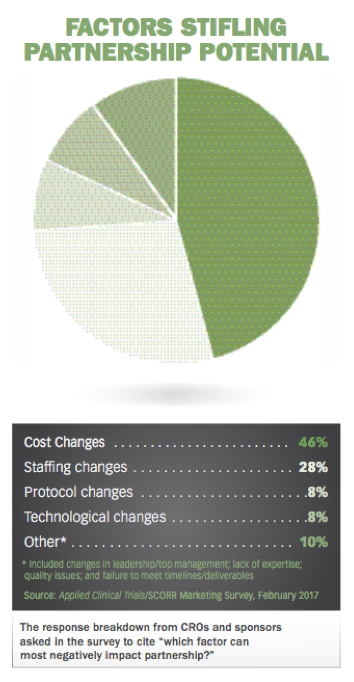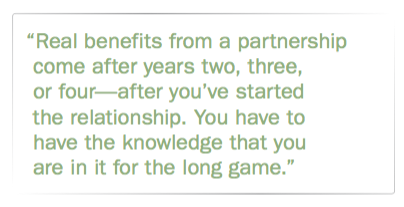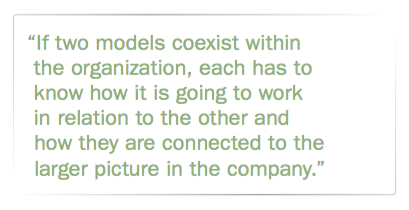Outsourcing in 2017: Playing to Win
Applied Clinical Trials
How CROs and sponsors can step up their relationship game.

Last month, Applied Clinical Trials brought together experts in contract research organization (CRO) and sponsor partnerships to provide their insights into this ever-evolving topic. First, we gathered choices as to what comprises the top outsourcing strategies and practices that need to change to drive higher collaborative value. This was chosen as our starting point based on a column by Kenneth Getz that appeared in the July/August 2016 issue of Applied Clinical Trials. The article outlined the challenges that remain in outsourcing models that negatively impact drug development operating performance. With our survey partner, SCORR Marketing, we gained further insights into outsourcing partner attributes, benefits, and general attitudes toward outsourcing models from our audience. The full survey report is available here.
Our expert panel members included Getz, Director, Sponsored Research Programs, Tufts CSDD, and Chairman, CISCRP, along with Murray Abramson, Vice President, Global Clinical Operations, Biogen; Phil Birch, Vice President, Innovation Strategy, Alliance Partnerships, ICON; Mitchell Katz, Head, Clinical Research & Drug Safety Operations, Purdue Pharma; and Andrew Schafer, President, Industry Standard Research.
At first glance, the list of challenges in outsourcing partnerships appeared long, as anyone involved with clinical trials outsourcing could imagine. Dissatisfactions from the CRO side included insufficient communication, poorly aligned processes, micromanagement, not involving CROs early in the process, and more. On the sponsor side, their dissatisfaction list included missed timelines, quality issues, and cost and out-of-scope amendments. And on both

sides, staffing changes was identified as a major challenge (see chart). But as the discussion progressed, Abramson made clear the point that many issues are a symptom…and the diagnosis is inconsistency in the partnership implementation.
“Micromanagement is a symptom, the changing of staff is a symptom, the lack of trust and insufficient communication is both a means and a symptom. It is the inconsistency of the way things are implemented,” said Abramson.
Keys to success
According to Abramson, consistency at both the internal and external levels is important because it fosters predictability. And that provides an organizational environment that allows for innovation and improvement to occur. “It doesn’t matter what sized organization you have-small, large, or mid-size, I think consistency is really important,” said Abramson. “And it doesn’t matter the approaches of outsourcing that a sponsor takes, it’s the internal of what the sponsor does and what the vendor does.”
To help build that consistency into the relationship, and in the organization across studies, Katz has developed a “CRO Playbook.” The playbook is one consistent way to manage a study and is structured by function, describes Purdue Pharma’s expectation from its CRO in those functions, and defines the roles and responsibilities of the sponsor and CRO. The playbook is continually refined or updated, used across CROs, and both the CRO and sponsor teams get the playbook.
“It has worked well for us,” said Katz. “Part of the problem I saw on the sponsor side is that we weren’t making our expectations clear, and if we did make them clear, it was only at the beginning of the program as opposed to throughout the program. [The playbook] is making it much easier, for different people coming in from different organizations to create and maintain consistency.”
Birch noted that investment in the partnerships is key. “Over the last two or three months, we’ve looked at the number of partnerships that we have set up at ICON and looked at the time we’ve spent upfront working closely with the sponsor to on-board the relationship,” he said. “There is a good correlation on the time spent doing that and the willingness of the sponsor to participate in that openly at all levels, with the success of the partnership.”
Discussions range from understanding the cultures, accountability, and making sure there’s not duplicated roles. Birch said, “If you get it right, the relationship goes more smoothly, and the trials do as well, because there is no confusion on who’s doing what. We have clarity on what the expectations are.”
Abramson, too, has a manual or playbook that creates a clear, transparent set of expectations. It’s continuously updated and serves as a shared source for sponsor and vendor. These playbooks also can serve as training tools, which Birch notes that everyone has to be re-trained on when a major revision occurs. This training should also be tracked on both sides for compliance.
As we see, consistency built internally and externally, with the playbook and the investment into communications, expectation-level-setting, etc., are the hallmarks of how successful strategic partnerships work.
“Real benefits from a partnership come after years two, three, or four-after you’ve started the relationship,” said Birch. “You have to have the knowledge that you are in it for the long game.”
State of outsourcing
The projected numbers for clinical research outsourcing spend from a recent presentation at J.P. Morgan are $30 billion (48% of total outsourced spend) for 2017 and $40 billion (55% of total) for 2020. A Research and Markets report from June 2015 said the average clinical trial outsourcing penetration in 2020 would likely reach around 72%, meaning three-fourths of clinical trials will be performed by CROs.
Schafer noted that based on his company’s research, as an industry we are nowhere near that 70% outsourcing penetration. However, he pointed out that it could be that high on a company-by-company basis. In ISR’s annual CRO Market Size report, it estimates that the CRO industry will grow at a 7% annual rate through 2021.
Outsourcing is a broad term encompassing transactional services, niche services, full-service arrangements and then various models under that, including fee-for-service, functional service providers, preferred providers, and strategic partnerships. Schafer noted that in the past six to nine months, when speaking with sponsors, they say they don’t have “preferred provider” relationships, they have strategic partnerships. “What we are hearing is there a shift to the upscale model continuum,” said Schafer.
In the ACT/SCORR survey, we asked companies how many were involved in a strategic (defined as pre-planned, longer-term) partnership. Almost half-49.1%-said yes. Of those who responded yes, we asked with how many partners and those answered range from one to five, with most being in the one-to-two range. With this question, we did not distinguish on company size, which is a factor in CRO-sponsor relationships.
The ACT/SCORR survey respondents felt that strategic partnerships have the most positive effect on large pharma, followed by large CROs. However, respondents also believed that

the largest negative effect was on small-to-mid-size biopharma. This effect was also discussed with the Applied Clinical Trials’ Editorial Advisory Board recently. With biopharma needing expertise to take their compounds further into clinical development before larger pharma comes in to develop further or license, they have found CROs prohibitively expensive. But some small-to-mid biopharma have found that by utilizing academic hospital networks, as well as targeted site networks, both possessing clinical trial expertise, has proven more viable.
The reasons behind the negative aspects of strategic relationships that our survey found could also be pipeline related. As Katz noted during the panel discussion, for smaller-to-medium size organizations that do not have a large pipeline, it becomes more difficult to engage and initiate these long-term relationships because “these partnerships are only as good as the strength of your pipeline.”
Additionally, and not a topic for our survey, the outsourcing of functions outside of a country-quite a trend four to six
years ago-hasn’t worked out as well as originally thought, as the panel discussed.
“We see those partnerships in developing countries have certainly decreased, whether they have been brought it in-house or companies are on-shoring the resources,” said Schafer. “But, absolutely, those agreements and partnerships have not panned out as anticipated.”
Birch identified two reasons for this reversal: quality and price. “The quality hasn’t always been there. And, over time, the price advantage decreases as well,” he said. “So the initial benefit diminishes over time.”
Getz noted: “I agree that we’re not seeing the level of off-shoring that we used to for a variety of reasons. Studies conducted by Tufts CSDD affirm Phil’s points and show that the price disparity for contract personnel and services in developed and developing countries has diminished over time, especially when you include the cost of oversight and logistical challenges. We’re also seeing a growing number of niche and larger CROs in developed countries-most notably North America and Western and Northern Europe-offering highly competitive positioning and winning share of these contracts.”
Abramson reiterated that, ultimately, if a company doesn’t have consistency in an internal sourcing model, or an external outsourcing model, it will still have a problem.
Models: You have to pick one
The panel members, based on their long history and success with strategic partnerships, were big fans of picking one model and sticking with it. Even if an organization prefers the functional service provider model, it is more successful, the experts say, to have one model with which to develop with a provider.
Abramson said he recently attended an event where a large company disclosed its new outsourcing model. While Abramson didn’t think it was new, he also thought the model was destined for failure. “They were going to use this model in only one therapeutic area, and then in only 60% of those therapeutic area trials would be using that model,” he said. “Then each of the other therapeutic areas in that company has its own outsourcing model. Mathematically, you are going into permutations by the thousands. You could see them jettison this model within a couple years.” Abramson advised, “You have to really narrow down the model or you have too much ambiguity in the system.”
Katz noted a situation where a hybrid model could work. “There are times where, based on the priority of the compound within a larger company’s pipeline, those priority projects are handled one way. And those that are not as important to the organization are fully outsourced,” he said. “This makes sure that all the projects keep moving. I like that hybrid model because it keeps things going.”
Abramson conceded that “one size does not fit all.” However, a different outsourcing model for each different therapeutic area, or two or three models for each different therapeutic area will not be successful, he contends. “You must have some kind of criteria, whether it’s by phase, or by priority, or therapeutic area,”
said Abramson.
He noted that if two models coexist within the organization, each has to know how it is going to work in relation to the other and how they are connected to the larger picture in the company. This internal communication and knowledge is important to the consistency key. “Too often, too many people are doing their own thing,” said Abramson. “There may

be pockets of consistency, but you won’t get the most value, whatever your definition of the value is, with inconsistency.”
Right mix essential
Who knows exactly what the future holds for outsourcing? There is a lot on the plate right now for pharmaceutical companies, including healthcare regulations, the approval process and pricing issues. This combination leads Katz to believe that organizations are going to outsource more. Birch added, “If you can create the right partnership in that setting, then you’ll generate more value than just having tactical outsourcing relationships.”
Just how successful and efficient a collaborative relationship can be depends on the right partner, a silver linings playbook, and the stamina to stick with it.
CRO-Sponsor Keys to the Game
#1 Playbook: Develop a living document on the roles, responsibilities and expectations for both the CRO and sponsor. This document is updated, and shared when updated. It is also useful for training.
#2 Consistency: Choose one outsourcing model and stick with it. Use the playbook to provide the consistency in roles and responsibilities.
#3 Training: Training is essential, especially when the playbook changes. Training should also be tracked for compliance.
#4: Stamina: The knowledge that you are going to be in the partnership for the long haul and will be putting in the effort and investment to make it work.

Improving Relationships and Diversifying the Site Selection Process
April 17th 2025In this episode of the Applied Clinical Trials Podcast, Liz Beatty, co-founder and chief strategy officer, Inato, discusses a number of topics around site engagement including community-based sites, the role of technology in improving site/sponsor relationships, how increased operational costs are impacting the industry, and more.
Behind the Buzz: Why Clinical Research Leaders Flock to SCOPE Summit
February 7th 2025In this episode, we meet with Micah Lieberman, Executive Conference Director for SCOPE Summit (Summit for Clinical Ops Executives) at Cambridge Innovation Institute. We will dive deep into the critical role of collaboration within the clinical research ecosystem. How do we bring together diverse stakeholders—sponsors, CROs, clinical trial tech innovators, suppliers, patients, sites, advocacy organizations, investors, and non-profits—to share best practices in trial design, program planning, innovation, and clinical operations? We’ll explore why it’s vital for thought leaders to step beyond their own organizations and learn from others, exchanging ideas that drive advancements in clinical research. Additionally, we’ll discuss the pivotal role of scientific conferences like SCOPE Summit in fostering these essential connections and collaborations, helping shape the future of clinical trials. Join us as we uncover how collective wisdom and cross-industry partnerships are transforming the landscape of clinical research.
FDA-Approved Gene Therapy Beqvez Shows Sustained Efficacy, Safety in Long-Term Hemophilia B Trial
April 17th 2025Beqvez (fidanacogene elaparvovec), an FDA-approved one-time gene therapy for hemophilia B, demonstrated sustained factor IX expression, low bleeding rates, and a favorable safety profile over long-term follow-up.